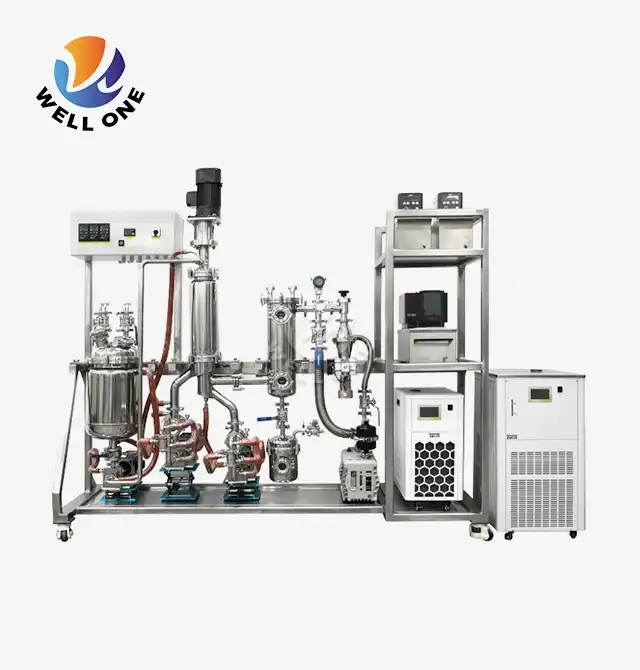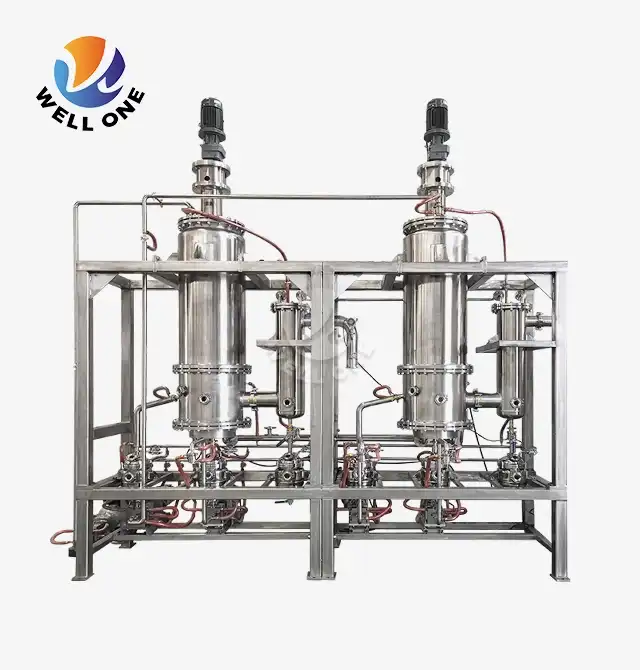How many types of distillation are used in a laboratory?
When processing heat-sensitive compounds like pharmaceutical APIs or essential oils, choosing the wrong distillation method can destroy your product's integrity, waste expensive raw materials, and delay your research timeline. Laboratory distillation encompasses approximately five to seven primary techniques, with Laboratory Molecular Distillation standing out as the most advanced option for separating thermally unstable compounds without degradation, operating under extreme vacuum conditions below 0.001 mbar.
Understanding Laboratory Distillation: The Foundation of Separation Science
Laboratory distillation represents a cornerstone separation technique utilized across pharmaceutical, food, petrochemical, and fine chemical industries. The fundamental principle involves heating a liquid mixture to create vapor, then condensing that vapor back into liquid form to achieve separation based on differing boiling points. However, conventional distillation methods often fail when processing heat-sensitive materials that degrade at elevated temperatures. This limitation has driven the evolution of specialized distillation variants, each designed to address specific molecular characteristics and process requirements. Modern laboratories typically employ simple distillation for straightforward separations, fractional distillation for complex mixtures, vacuum distillation for temperature-sensitive compounds, steam distillation for volatile organic compounds, and Laboratory Molecular Distillation for the most delicate separation challenges.
Simple Distillation in Laboratory Settings
Simple distillation serves as the most basic separation method, ideal when components have boiling points differing by at least 25°C. This technique involves heating a mixture in a round-bottom flask, vaporizing the more volatile component, and condensing it in a separate collection vessel. Researchers commonly apply simple distillation for solvent purification, water distillation, and preliminary separations. The apparatus typically includes a heating source, distillation flask, condenser, and receiving flask connected in series. While straightforward and cost-effective, simple distillation provides limited separation efficiency for complex mixtures or closely related compounds. Laboratory Molecular Distillation surpasses this method by operating under high vacuum, enabling separation at significantly lower temperatures, thus preserving compound integrity.
Fractional Distillation for Complex Mixture Separation
Fractional distillation introduces a fractionating column between the distillation flask and condenser, creating multiple vaporization-condensation cycles. This column contains packing materials or structured internals that increase surface area for vapor-liquid contact, dramatically improving separation efficiency. The technique proves essential for separating components with boiling points differing by as little as 10°C. Petroleum refineries utilize industrial-scale fractional distillation, while laboratories employ smaller columns for purifying organic compounds, analyzing essential oil compositions, and separating reaction products. The number of theoretical plates in the column determines separation capability, with longer columns providing better resolution. However, fractional distillation still requires elevated temperatures that can damage thermally labile compounds, a limitation overcome by Laboratory Molecular Distillation technology operating at 50°C to 300°C with precise temperature control.
Vacuum Distillation: Reducing Thermal Stress
Vacuum distillation lowers system pressure to reduce boiling points, enabling distillation of high-boiling or heat-sensitive materials at lower temperatures. By creating partial vacuum conditions, this method prevents thermal decomposition while maintaining reasonable distillation rates. Pharmaceutical laboratories frequently employ vacuum distillation for concentrating reaction mixtures, purifying natural products, and recovering valuable solvents. The technique requires vacuum pumps capable of achieving pressures from 10 to 100 mbar, along with specialized glassware designed to withstand pressure differentials. While vacuum distillation significantly reduces thermal stress compared to atmospheric methods, Laboratory Molecular Distillation pushes vacuum levels to extreme depths below 0.001 mbar, virtually eliminating thermal degradation risks. Systems constructed from corrosion-resistant 316 stainless steel ensure durability when processing aggressive chemicals.
Advanced Laboratory Molecular Distillation Technology
Laboratory Molecular Distillation represents the pinnacle of separation technology for heat-sensitive, high-boiling compounds. This technique operates on the principle that under extremely high vacuum conditions, molecules travel freely from the heated evaporating surface to the condensing surface without collisions, provided the distance between surfaces is less than the mean free path of molecules. This short-path configuration enables distillation at temperatures 100°C to 200°C below conventional boiling points, preserving delicate molecular structures. The method proves indispensable for purifying pharmaceutical intermediates, refining natural extracts, and processing specialty chemicals where conventional distillation would cause degradation. Laboratory Molecular Distillation systems feature evaporation surfaces ranging from 0.1 to 2 m², expandable for scaling from research to production. Advanced ABB PLC control systems maintain temperature precision within ±0.1%, ensuring reproducible results across batches.
Single-Stage vs. Multi-Stage Laboratory Molecular Distillation
Single-stage Laboratory Molecular Distillation systems provide effective separation for binary mixtures or initial purification steps, offering straightforward operation and lower capital investment. The feed material spreads across a heated cylindrical surface while rotating wipers maintain thin film thickness, maximizing evaporation efficiency. Light components vaporize and condense on an internal cooling surface positioned just millimeters away, while heavy residue discharges continuously. For more demanding separations, dual-stage and three-stage Laboratory Molecular Distillation configurations enable sequential purification, each stage targeting specific compound fractions. Multi-stage systems dramatically improve product purity, achieving levels exceeding 98% for applications like squalene purification or EPA/DHA concentration from fish oils. The distillate from one stage feeds directly into the next, with intermediate cooling and pressure adjustments optimizing each separation step. Xi'an Well One Chemical Technology Co., Ltd. supplies single-stage, dual-stage, and three-stage Laboratory Molecular Distillation systems, all certified to CE, ISO, UL, and SGS standards with a high vacuum degree reaching 0.1Pa.
Steam Distillation for Natural Product Extraction
Steam distillation injects steam into plant materials or other natural sources, carrying volatile compounds into a condenser where the steam-compound mixture separates into aqueous and organic phases. This gentle extraction method proves ideal for essential oils, fragrances, and flavor compounds that would decompose under direct heating. The technique operates at temperatures below 100°C due to the partial pressure contribution of water vapor, protecting thermally sensitive constituents. Rose essential oil, lavender oil, and eucalyptus oil production commonly employs steam distillation as a preliminary extraction step. However, crude extracts typically require further purification to remove unwanted components, off-odors, and residual water. Laboratory Molecular Distillation excels at this secondary refinement, producing high-purity rose essential oil with preserved aromatic profiles. The combination of steam distillation followed by Laboratory Molecular Distillation delivers superior quality compared to traditional dewaxing methods that risk molecular rearrangement and oxidation.
Industry-Specific Applications of Laboratory Distillation Methods
Different industries prioritize specific distillation techniques based on their unique process requirements and product specifications. Pharmaceutical manufacturers demand GMP-compliant designs with CIP/SIP capabilities, utilizing Laboratory Molecular Distillation for purifying active pharmaceutical ingredients, lipid nanoparticles, and vaccine components while maintaining stringent documentation. Food industry applications focus on preserving nutritional value and sensory qualities, employing Laboratory Molecular Distillation for fish oil purification to concentrate omega-3 fatty acids, achieving 70% recovery rates with excellent color and low peroxide values. The petrochemical sector requires robust, corrosion-resistant equipment for lubricating oil regeneration and base oil production, where multi-stage Laboratory Molecular Distillation enables fraction cutting and quality base oil recovery from waste streams. Essential oil and fragrance industries leverage gentle separation to preserve delicate aromas in CBD extracts, citrus oils, and botanical concentrates, utilizing short-path distillation with nitrogen inertization. Research laboratories demand versatile bench-top units with interchangeable condensers, real-time data logging, and modular configurations that scale seamlessly from pilot trials to full production.
Pharmaceutical Industry: PEG Synthesis and API Purification
Polyethylene glycol synthesis demonstrates the critical role of advanced reactor and separation technologies in pharmaceutical manufacturing. Traditional batch reactors struggle to control molecular weight distribution during PEG polymerization, resulting in products with dispersity indices above 1.05 even under high-purity conditions. Microchannel reactors overcome these limitations by enabling controllable multiphase micro-scale flows that enhance mixing, mass transfer, and heat transfer during polymerization. These reactors strictly control reaction time through modular unit assembly, producing PEG with single molecular weight distributions. Following synthesis, Laboratory Molecular Distillation purifies the PEG product, removing unreacted monomers, catalyst residues, and oligomers to meet pharmaceutical excipient standards. The GMP-compliant design with 316L stainless steel construction ensures product purity and regulatory compliance. Similarly, squalene purification from plant sources requires Laboratory Molecular Distillation to remove fatty acids and ester impurities after liquid phase extraction and saponification processing. Multi-stage Laboratory Molecular Distillation improves yield, recovers solvents, and achieves product purity reaching 98%, meeting stringent pharmaceutical and cosmetic industry requirements.
Food Industry: Fish Oil and Tea Oil Processing
Fish oil purification exemplifies the superior performance of Laboratory Molecular Distillation over traditional separation methods. Crude fish oil contains valuable EPA and DHA alongside other unsaturated fatty acids, color bodies, fishy odor compounds, and oxidation products. Traditional separation achieves only 16% recovery with products requiring extensive decolorization and deodorization. By contrast, Laboratory Molecular Distillation exploits the similar mean free path of impurity fatty acids and EPA/DHA ethyl esters to achieve 70% recovery rates. The process begins with esterification, washing, and dehydration to produce fish oil ethyl ester, followed by degassing and deodorizing through a thin film evaporator. A four-stage Laboratory Molecular Distillation system then separates products containing 80% combined DHA and EPA with excellent color, pure odor, and low peroxide values. The modular configuration enables production of various DHA/EPA ratio products for different market segments. Tea oil deacidification represents another food application where Laboratory Molecular Distillation outperforms conventional alkaline refining. As a healthy premium edible oil promoted by the FAO, tea oil contains free fatty acids that negatively impact storage stability and nutritional value. Traditional alkaline refining uses complex processes that damage beneficial components while generating waste. Laboratory Molecular Distillation, as a liquid-liquid separation technology with low operating temperature, high vacuum degree, and high separation efficiency, gently removes free fatty acids without compromising tea oil quality.
Technical Specifications and Quality Assurance in Laboratory Molecular Distillation
Modern Laboratory Molecular Distillation systems incorporate sophisticated engineering to deliver consistent, reproducible results. Temperature control ranges from 50°C to 300°C with adjustable parameters accommodating different heat-sensitive materials, maintained by precision heating elements and sensors. Vacuum systems achieve levels below 0.001 mbar through multi-stage pumps and specialized sealing technologies, minimizing thermal stress on processed compounds. Evaporation surface areas span 0.1 to 2 m² with expandable designs for high-throughput applications, featuring rotating wipers that maintain optimal film thickness for efficient heat and mass transfer. Control systems utilizing ABB PLC technology ensure repeatable results with ±0.1% accuracy, incorporating real-time data logging and process monitoring capabilities. Compliance with CE, ISO 9001, ATEX, and FDA 21 CFR Part 11 standards demonstrates commitment to quality and regulatory requirements. Equipment constructed from 316L stainless steel provides corrosion resistance for aggressive chemicals and food-grade applications, with surface finishes meeting pharmaceutical cleanliness standards. Automated CIP/SIP systems simplify validation procedures, while modular designs facilitate scaling from laboratory research to industrial production. One-year warranties with extendable maintenance plans protect customer investments, backed by comprehensive technical support and spare parts availability.
OEM & ODM Customization Capabilities
Xi'an Well One Chemical Technology Co., Ltd. provides extensive OEM and ODM services, designing customized Laboratory Molecular Distillation solutions tailored to specific process requirements. The engineering team utilizes 3D modeling software to visualize equipment configurations, optimizing footprint utilization and integration with existing facilities. Custom solutions range from compact bench-top units for academic research to multi-stage industrial systems processing hundreds of kilograms per hour. Electrical accessories comply with UL Listed standards, matched with premium auxiliary equipment from brands like Huber for heating and cooling functions. Glass feeding tanks with compact designs accommodate various raw material characteristics, while external condensers and structural support systems adapt to facility constraints. The R&D laboratory enables feasibility studies and process development, testing customer samples to determine optimal operating parameters before equipment fabrication. Pilot testing services validate scalability, ensuring production equipment meets capacity and quality targets. This comprehensive approach from concept through commissioning minimizes project risks and accelerates time to production.
Selecting the Right Distillation Method for Your Laboratory
Choosing appropriate distillation technology requires careful evaluation of feedstock properties, target compound characteristics, purity requirements, throughput needs, and budget constraints. For simple separations with thermally stable compounds and large boiling point differences, conventional simple or fractional distillation provides cost-effective solutions. When processing temperature-sensitive materials with moderate purity requirements, vacuum distillation offers a reasonable compromise between performance and investment. Applications demanding maximum purity, gentle processing, and preservation of delicate molecular structures necessitate Laboratory Molecular Distillation despite higher capital costs. The investment proves justified when processing high-value products where yield losses from degradation would outweigh equipment expenses. Multi-stage Laboratory Molecular Distillation configurations suit complex separations requiring sequential purification steps, particularly for natural product refining and specialty chemical production. Consulting with experienced equipment manufacturers enables accurate process simulation, laboratory testing with actual feedstocks, and customized system design optimized for specific applications. Xi'an Well One Chemical Technology Co., Ltd. maintains a 500 m² R&D laboratory conducting feasibility research, process development, and pilot testing to ensure customer production equipment achieves target capacity and product quality based on experimental results.
Conclusion
Laboratory distillation encompasses diverse techniques from simple atmospheric distillation to advanced Laboratory Molecular Distillation, each suited to specific separation challenges. Understanding the approximately five to seven primary methods enables researchers and engineers to select optimal technologies for their applications. Laboratory Molecular Distillation represents the gold standard for heat-sensitive, high-value compounds requiring gentle processing and exceptional purity.
Cooperate with Xi'an Well One Chemical Technology Co., Ltd
Since 2006, Xi'an Well One Chemical Technology Co., Ltd, backed by Xi'an NewSet Chemical Equipment Technology Co., Ltd, has specialized in synthesis and purification separation equipment. With a 1,500 m² office, 500 m² R&D lab, and 4,500 m² factory, the company offers comprehensive process development, equipment design, testing, and pilot services. As a leading China Laboratory Molecular Distillation factory, China Laboratory Molecular Distillation supplier, and China Laboratory Molecular Distillation manufacturer, we deliver molecular distillation devices from lab to industrial scale. Our China Laboratory Molecular Distillation wholesale programs provide High Quality Laboratory Molecular Distillation at competitive Laboratory Molecular Distillation prices, with Laboratory Molecular Distillation for sale in single-stage, dual-stage, and three-stage configurations. All equipment meets CE, ISO, UL, and SGS certification standards, featuring ABB control systems, 316 stainless steel construction, high vacuum degree of 0.1Pa, and comprehensive OEM & ODM support with 1-year warranty. Transform your separation challenges into opportunities—contact our expert team at info@welloneupe.com to discuss customized solutions for pharmaceutical, food, petrochemical, essence, and fine chemical applications. Bookmark this guide for reference whenever selecting distillation equipment for your laboratory or production facility.
References
1. Perry, R.H. and Green, D.W., "Perry's Chemical Engineers' Handbook," McGraw-Hill Education, 9th Edition - Section on Distillation and Gas Absorption
2. Seader, J.D., Henley, E.J., and Roper, D.K., "Separation Process Principles: Chemical and Biochemical Operations," John Wiley & Sons, 4th Edition
3. Lutisan, J. and Cvengros, J., "Mean Free Path of Molecules on Molecular Distillation," The Chemical Engineering Journal and the Biochemical Engineering Journal
4. Batistella, C.B. and Maciel, M.R.W., "Molecular Distillation: Rigorous Modeling and Simulation for Design and Performance Evaluation," Applied Biochemistry and Biotechnology







